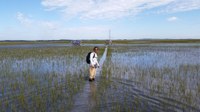Fellowships help graduate student trace carbon cycling in salt marsh

Meteorology doctoral student Jesus Ruiz-Plancarte stands in a salt marsh in Oyster, Virginia, where he conducts research on how plants assimilate carbon dioxide from the atmosphere. Image: Jesus Ruiz-Plancarte
UNIVERSITY PARK, Pa. — Penn State meteorology graduate student Jesus Ruiz-Plancarte loves hands-on research. Since 2013, he’s been able to do just that with the help of several prestigious fellowships.
Ruiz-Plancarte conducts research on a salt marsh along the Virginia coastline, focusing on the total photosynthetic production of carbon-based compounds in the ecosystem. Since photosynthesis involves the creation of sugars from carbon dioxide by plants, tracing the carbon cycle throughout the plants in a salt marsh ecosystem is a key facet of this particular line of research.
“I’m calculating how much carbon is being exchanged by the ecosystem with the atmosphere, otherwise known as net ecosystem exchange (NEE),” Ruiz-Plancarte said. “With the concentrations of greenhouse gases in the atmosphere increasing and with sea level rising, measuring how much carbon dioxide can be taken in by coastal ecosystems is important.”
